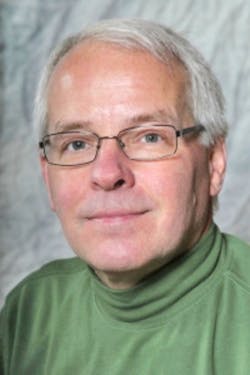EMC Symposium keynoter considers the implications of an everything-wireless world
National Harbor, MD. Julius Knapp kicked off the International EMC Symposium and Power and Signal Integrity Symposium today with a keynote address titled “Achieving EMC in an Everything-Wireless World.” Knapp has been with the FCC for 42 years and has served as the chief of the FCC’s Office of Engineering and Technology (OET) since 2006.
EMC Symposium attendees constitute a tough crowd, he joked: “You actually know what a dB is.” He also noted that it’s a miracle that the Washington, DC, area temperatures aren’t 95 degrees with humidity at 80%. He suggested that the symposium committee might have more clout than he could ever imagined.
He looked back on other EMC Symposiums held in Washington, including the 1983 edition, which marked the 25th anniversary of founding of EMC Society. Cellphones were in year 1, with commercial service having just been introduced, and most people hadn’t heard of the Internet. Hot topics included spectrum management, EMC analysis and measurement, EMP, ESD, filters, shielding, and open-field testing.
By the time the 1990 version of the show came back to Washington, he said, cellphones were still 1G. Hot topics included spectrum management, EMC analysis and measurement, EMP, ESD, filters…not much had changed.
But by the time he delivered a keynote address at the 2000 version, cellphones had progressed to 2G, with 3G not too far off. He noted that the “IMT-2000” designation for 3G fell out of favor, with the technology’s introduction delayed until 2003. Nevertheless, the Internet had arrived.
Today, 2017, he said, we are well alone in 4G, with 5G just around the corner. Most people have access to broadband now, yet a challenge remains—how to make sure everybody has access. New topics are appearing, or at least becoming more prominent, he said, including the IoT and medical and nuclear-industry applications. But spectrum management remains important for addressing spectrum challenges over the next ten years.
At one point he asked, “What is EMC?” A common thread includes standards, allocations, and rules that apply to spectrum usage not just over the air but in wires as well—a fact that’s often overlooked. He noted that his organization handles non-federal uses of spectrum, while NTIA addresses federal usage.
“Wireless is integrated into every part of our lives,” he said. “Imagine a world without wireless. You would have to use a key to open your car.”
He continued, “But there is no turning back. Applications for wireless are only going to grow at a faster pace.” Nowadays nearly home product comes with connectivity—your refrigerator, sofa, bed, socks, and shorts. Sometimes it might be best not to ask the ultimate purpose of many of these items, he said—the goal of the EMC engineer is to make sure all these things can coexist.
“Spectrum policy is enabler of these new technologies and services,” he said, and he presented a series of slides full of facts and figures describing FCC and industry initiatives, including the television spectrum reverse auction with freed-up bands repurposed for technologies like ATSC 3.0 and CBRS. The slides will be available to attendees, and if you are not in Washington this week you can take advantage of the EMC+SIPI 2017 Online Symposium, with more than 1,000 people form more than 65 countries expected to register, according to show organizers.
Knapp said ongoing activity will bring change. You might be designing products whose adjacent bands might now be relatively quiet, but that’s likely to change, with immunity becoming more important. “Expect the unexpected,” he advised. “You are all going to be busy.”
He concluded by making predictions for EMC 2030. We may be dealing with 6G and autonomous vehicles, and AI might have a role to play in EMC. But it’s a safe bet that spectrum management will remain a key topic, he said, adding, “Remember that EMC starts in the design process.”
About the Author

Rick Nelson
Contributing Editor
Rick is currently Contributing Technical Editor. He was Executive Editor for EE in 2011-2018. Previously he served on several publications, including EDN and Vision Systems Design, and has received awards for signed editorials from the American Society of Business Publication Editors. He began as a design engineer at General Electric and Litton Industries and earned a BSEE degree from Penn State.
